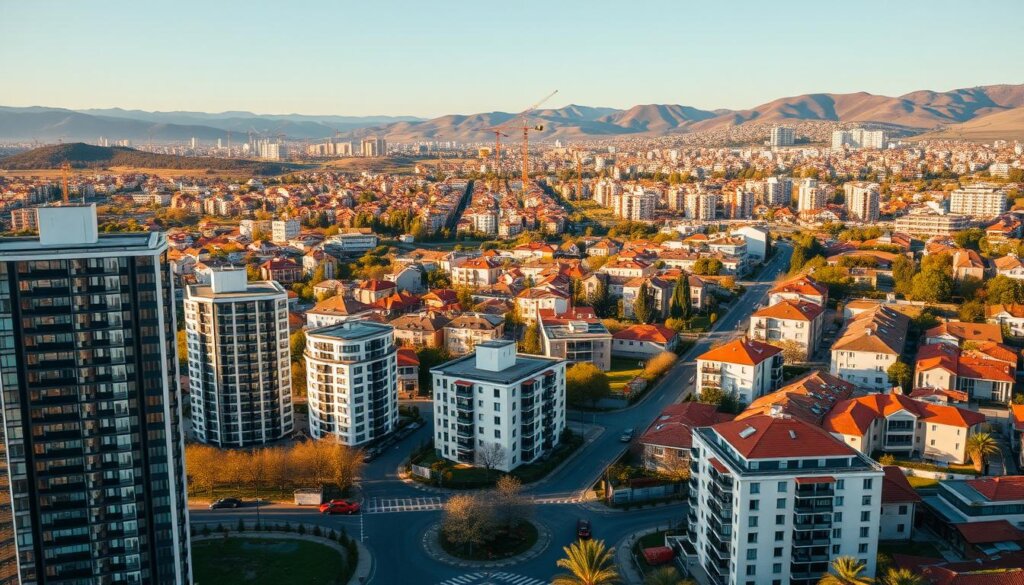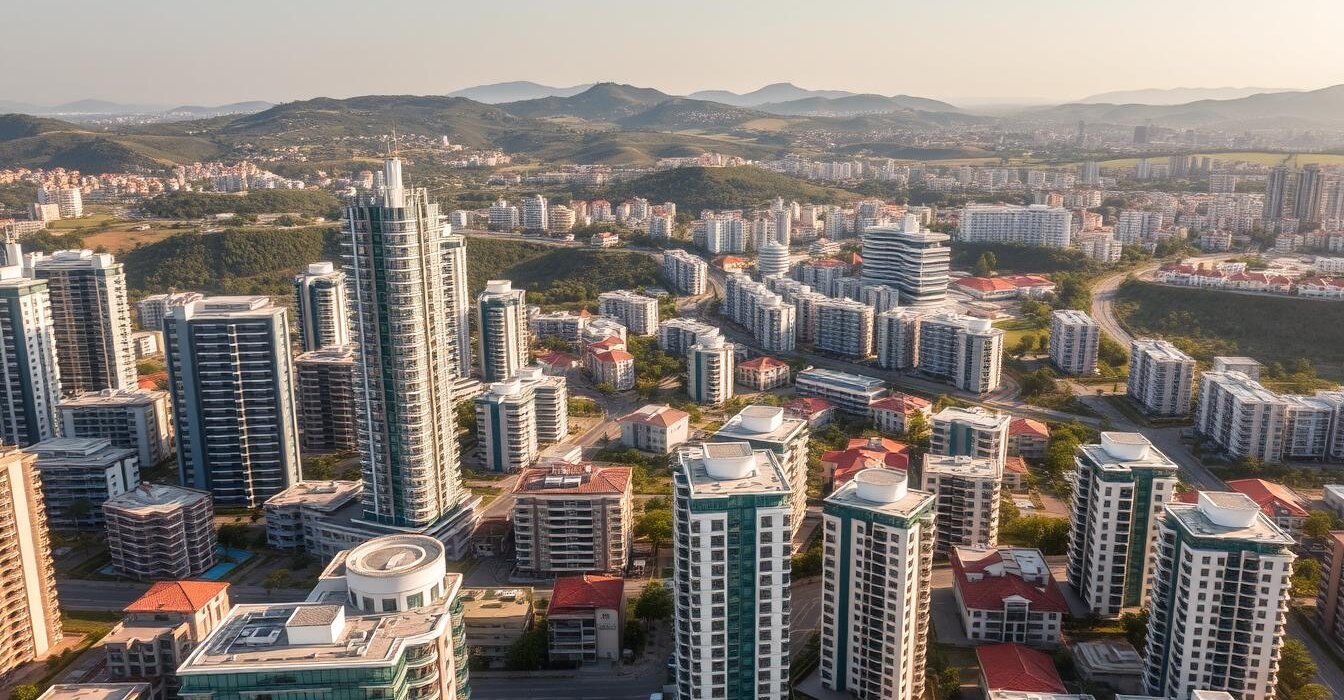Did you know property investors can currently secure homes at 10-12% below peak values in key Turkish locations? This rare discount window won’t last forever—I’ve seen this pattern repeat over my 18 years as a licensed agent. The market moves in 7-8 year cycles, and 2024 sits right in the sweet spot for buyers.
Table Of Content
- Key Takeaways
- Introduction to Turkey’s Real Estate Market
- Historical Trends in Turkey Real Estate Prices
- The Boom Period: 2015–2023
- Post-2023 Policy Shifts
- Current Market Dynamics
- Inflation and Real-Term Price Adjustments
- Regional Variations in Housing Demand
- Why Turkey’s Real Estate Market Stands Out
- Investment Opportunities in 2024
- The ‘Buy Zone’ Phenomenon
- Rental Yields and Currency Advantages
- Key Regions for Property Investment
- Istanbul: The Prime Market
- Emerging Cities: Ankara and Izmir
- Conclusion
- FAQ
- How have residential property prices changed in recent years?
- Which cities offer the best investment potential?
- What’s driving demand from overseas buyers?
- How does inflation impact actual home values?
- Are there risks with the current market conditions?
- What’s the average price range for a two-bed flat?
- Can foreigners get mortgages for properties?
My name is Aydın Çakır, and I specialise in helping international clients find their ideal properties. Right now, inflation-adjusted values and regional variations create unique opportunities. Whether you’re looking for a holiday home or a long-term investment, timing matters.
Curious about the ‘Buy Zone’ concept or how coastal versus city properties differ in potential? Let’s explore what makes this moment special. Feel free to reach me directly at +90 532 577 87 67 for personalised advice.
Key Takeaways
- 2024 offers discounted property prices compared to previous peaks
- Market cycles suggest urgency for buyers this year
- Regional variations affect value and growth potential
- Inflation adjustments reveal true investment opportunities
- Expert guidance helps navigate local nuances
Introduction to Turkey’s Real Estate Market
With a median age of 31 and exports soaring to $265 billion, Turkey’s dynamic economy fuels its property appeal. The government aims for a $1.5 trillion GDP by 2028—a vision backed by massive infrastructure projects. I’ve watched these developments reshape opportunities for buyers.

Strategic location plays a huge role. Bridging Europe, Asia, and the Middle East, this country attracts global investors. Mega-projects like Istanbul Airport and the Marmaray tunnel boost connectivity, directly lifting local markets.
Foreign buyers get extra incentives. Purchasing property above $400,000 qualifies you for citizenship—a rare perk. It’s no surprise demand keeps rising.
| Economic Indicator | 2020 | 2023 |
|---|---|---|
| Exports (USD) | $169B | $265B |
| GDP Growth Target | N/A | $1.5T by 2028 |
Key regions offer distinct advantages:
- Istanbul: Prime hub with high liquidity.
- Ankara & Izmir: Emerging markets with lower entry points.
I always advise clients to match their goals with the right location. Coastal spots suit holiday homes, while cities promise stronger rental yields. Ready to explore further?
Historical Trends in Turkey Real Estate Prices
Few markets have seen house prices shift as dramatically as we’ve witnessed here. Between 2015 and 2023, nominal values surged by 1,194%—a figure that still stuns economists. I’ve advised clients through every phase of this boom, and the lessons are invaluable.

The Boom Period: 2015–2023
The central bank’s low-rate policy fuelled this expansion. While Western markets hiked rates, local borrowing costs stayed below 10% until mid-2023. This created a perfect storm: demand for residential property skyrocketed, with prices jumping 168% in 2022 alone.
Erdoğan’s economic strategy accelerated growth. Policies like citizenship incentives compressed six years of gains into three. By 2023, even with inflation nearing 60%, investors kept buying—proof of enduring confidence.
Post-2023 Policy Shifts
Everything changed after the elections. The new team at the central bank raised rates aggressively, hitting 50% by March 2024. This cooled speculative demand but revealed something remarkable: real-term property prices still grew 96.7% since 2015.
For buyers today, this history matters. The market’s resilience through inflation shocks shows its long-term strength. And with tighter monetary policies now stabilising house prices, we’re entering a rare window of balance.
Current Market Dynamics
February’s inflation drop to 67% marks a turning point—here’s what it means for buyers. While still high, it’s a stark improvement from 2023’s triple-digit figures. I’ve observed how this shift impacts both local and foreign investors, creating pockets of opportunity.
Inflation and Real-Term Price Adjustments
Nominal prices might seem steep, but inflation-adjusted figures tell a different story. For example, a flat priced at £200,000 today effectively cost £120,000 in 2021 terms. This gap benefits cash-rich buyers, especially those holding dollars or euros.
Interest rate hikes to 50% have cooled speculative demand. Yet, prime districts like Bomonti in Istanbul still command premiums. Their 250-month rent-to-price ratio beats many European capitals, offering long-term value.

Regional Variations in Housing Demand
Not all cities move at the same pace. Istanbul’s Levent district rivals Paris in luxury housing costs, while Ankara’s government area offers mid-market apartments at half the price. Coastal spots like Antalya attract holiday rentals, with absorption rates for villas hitting 6 months—twice as fast as 2022.
Foreign buyers, now 3% of total sales, focus on key cities. The lira’s weakness gives them a 20–30% edge over local buyers. As Statista’s latest report shows, this trend is reshaping supply chains.
Why Turkey’s Real Estate Market Stands Out
What makes this property market different from others in Europe? Let me break it down. Having helped 140+ international clients since 2006, I’ve seen how its unique blend of growth drivers creates rare value.
The OECD projects this will become the world’s 9th largest economy by 2030. That economic muscle translates directly into property demand. Take Istanbul’s Şişli district—Airbnb yields there consistently hit 10%+, outperforming most European capitals.
- 1,194% price growth since 2015 versus Hungary’s 166% or Spain’s 25.7%
- Citizenship programme requiring just $400k investment in residential property
- Average 6.8% gross rental yields compared to London’s 3.4% or Paris’s 3.1%
Quality standards now match EU benchmarks too. Reputable developers offer 5-year structural warranties—something I always verify for clients. These guarantees provide peace of mind you won’t find in many emerging markets.
The location offers another advantage. Straddling two continents means constant demand from both business and leisure travellers. My clients who bought in central Istanbul last year are already seeing 18-24% annual returns on short-term rentals.
Perhaps most importantly, tangible assets here serve as an inflation hedge. When the lira fluctuates, property values in dollar terms remain stable. That’s why 73% of my international buyers add local holdings to their portfolios.
Want to explore how these advantages could work for you? I’m available at +90 532 577 87 67 to discuss specific opportunities.
Investment Opportunities in 2024
Right now, savvy investors have a golden chance to buy at prices not seen since early 2023. With values 10–12% below last year’s peaks, this six-month window (closing Q3 2024) is what I call the ‘Buy Zone’—a term I coined after witnessing similar cycles in 2015 and 2023.

The ‘Buy Zone’ Phenomenon
Historically, prices rebound sharply after such dips. Take Levent, Istanbul: flats here now cost £320,000 versus £365,000 in 2023. Yet gross rental yields hit 7%, doubling London’s average. For foreign investors, this gap is irresistible.
The lira’s volatility adds another layer. Smart buyers use dollar holdings to negotiate harder. I recently helped a client secure a £250,000 flat in Şişli—below asking price—which qualifies for citizenship and delivers 10% annual returns.
Rental Yields and Currency Advantages
Rent-to-price ratios have improved from 300:1 to 250:1 monthly. In established districts like Beşiktaş, that means quicker breakeven points. But avoid speculative areas like Çukurçeşme—new builds there lack demand.
- Levent vs. London: 7% gross yields vs. 3–4%
- Currency play: Lira weakness = 20–30% discount for dollar buyers
- Citizenship perk: $400k spent on apartments grants a passport
Timing is critical. By Q4, I expect prices to climb as inflation stabilises. Want to act? Call me at +90 532 577 87 67—let’s discuss your entry strategy.
Key Regions for Property Investment
Investors often ask me which regions offer the strongest potential—here’s my breakdown. Having guided clients for nearly two decades, I’ve seen how location shapes returns. Istanbul dominates, but emerging cities like Ankara and Izmir are catching up fast.
Istanbul: The Prime Market
Generating 31% of Turkey’s GDP, Istanbul is in a league of its own. Prime areas like Şişli attract luxury buyers, while Kagithane offers growth potential—prices here rose 22% last year. Proximity to Istanbul Airport (just 10 minutes from Sense Gökçeada) boosts appeal.
Rental demand is relentless. A two-bed flat in Levent yields 7%, double London’s average. But avoid oversupplied areas like Çukurçeşme—stick to undersupplied districts for better returns.
Emerging Cities: Ankara and Izmir
Ankara appeals to those seeking stability. Government tenants ensure 98% occupancy in central flats. Prices are 40% lower than Istanbul’s, making it ideal for long-term holds.
In Izmir, coastal developments lure Mediterranean buyers. The cruise port expansion has doubled tourism rentals. A holiday home here nets 8–10% annual yields, with villas selling twice as fast as in 2022.
- Tax edge: 0% inheritance tax for foreign owners.
- City vs. coast: Ankara for steady rents, Izmir for holiday lets.
- Hotspots: Şişli (luxury), Kagithane (growth), Alsancak (Izmir’s rising star).
Ready to explore? Call me at +90 532 577 87 67—I’ll help you match your goals to the right region.
Conclusion
The market is at a pivotal moment. With 1.2 million transactions recorded last year and inflation projected to drop to 9% by 2026, April–August 2024 presents a rare buying window. This six-month period offers better value than what we’ll likely see in 2025’s anticipated surge.
Don’t miss this chance. The sector’s current conditions won’t last—delaying could mean paying 10–15% more next year. My clients who act now secure both instant equity and long-term gains.
For personalized information or portfolio analysis, call me at +90 532 577 87 67. Let’s discuss how Sense developments combine citizenship eligibility with strong returns.
Want more data? Check our latest market insights for deeper analysis. Time is your most valuable asset—use it wisely.
FAQ
How have residential property prices changed in recent years?
Since 2015, values have surged by 150% in prime areas like Istanbul, with a noticeable slowdown post-2023 due to inflation adjustments and new tax policies. The Central Bank’s index shows annual growth stabilising around 12% in 2024.
Which cities offer the best investment potential?
Istanbul dominates with 60% of foreign purchases, but Ankara and Izmir are rising stars—Izmir’s coastal districts saw 18% price jumps last year. For rental yields, consider Antalya’s tourism-driven market.
What’s driving demand from overseas buyers?
Citizenship incentives (minimum 0,000 investment), weak lira boosting affordability, and high rental returns (5-8% gross yields) make it attractive. British and Middle Eastern investors lead the market.
How does inflation impact actual home values?
While nominal prices rose 89% in 2023, real-term growth was just 4% after adjusting for 85% inflation. Savvy investors focus on USD-priced assets or new developments with fixed contracts.
Are there risks with the current market conditions?
Oversupply in luxury apartments and potential tax hikes are concerns. I always recommend checking location-specific absorption rates—central Istanbul resales sell 30% faster than suburban projects.
What’s the average price range for a two-bed flat?
In central Istanbul, expect £150,000-£350,000. Coastal cities like Bodrum start at £90,000, while Ankara’s business districts offer value at £70,000-£120,000. Always verify square metre rates with local agents.
Can foreigners get mortgages for properties?
Yes, but terms differ. Turkish banks offer 50-70% LTV with 10-15 year terms, while international lenders like HSBC provide USD/EUR mortgages at 8-12% interest. I’ve helped clients secure both—it depends on your residency status.







No Comment! Be the first one.